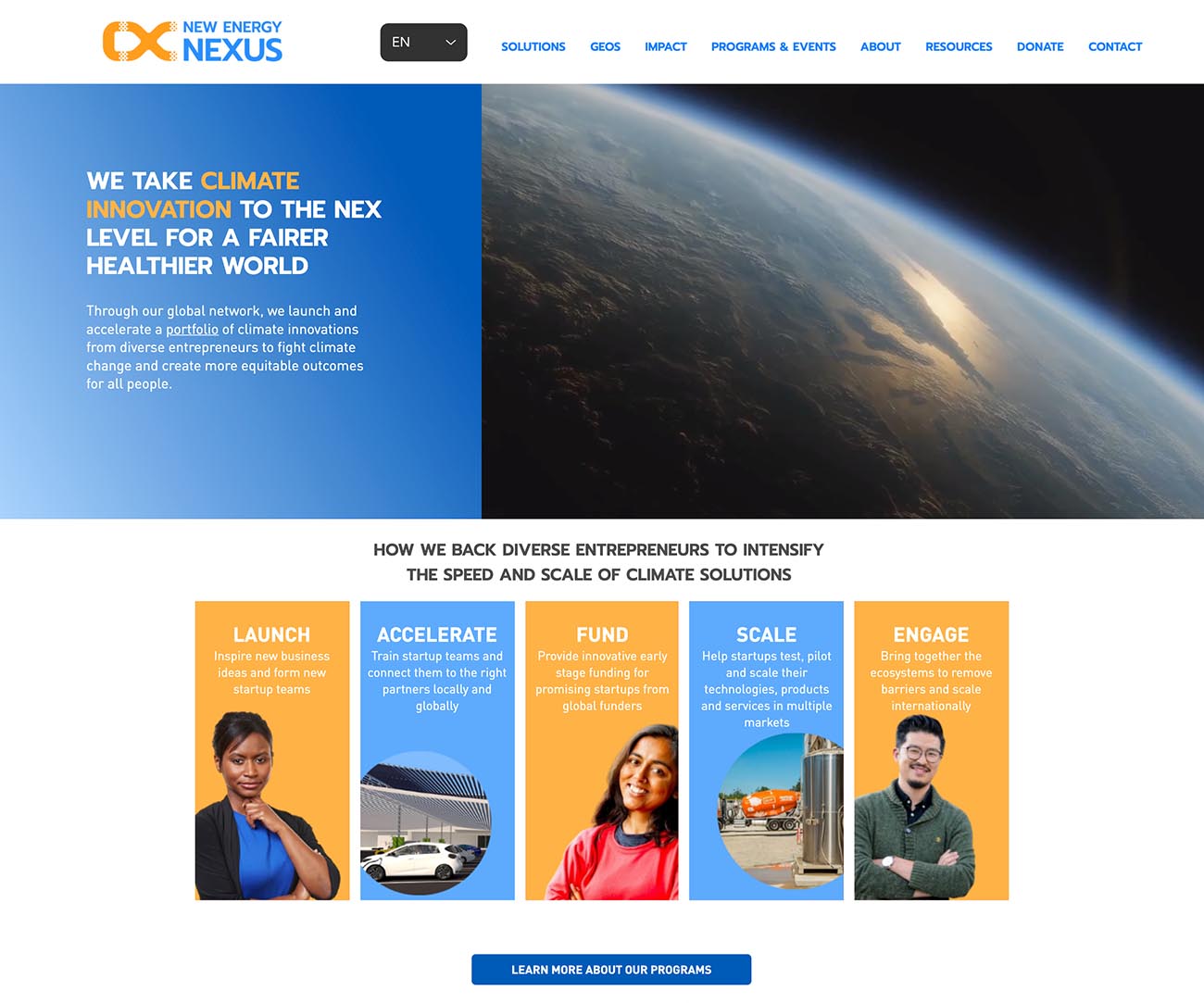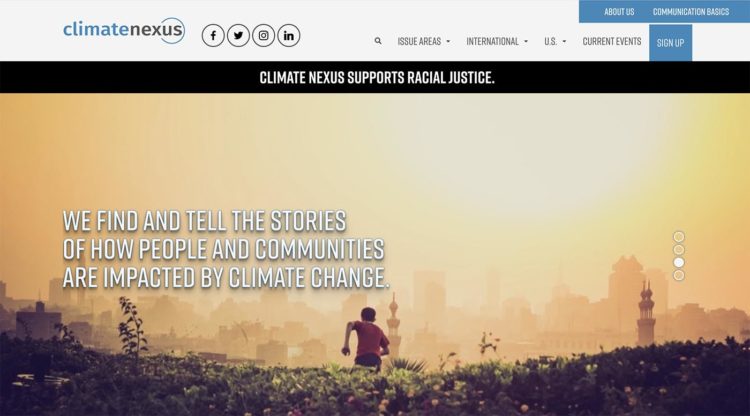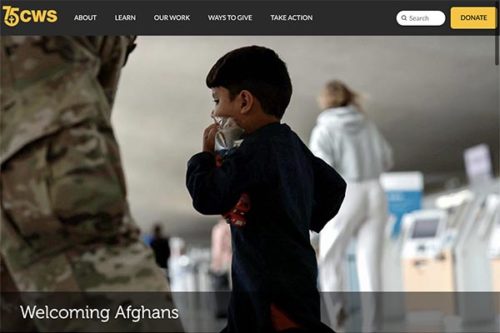September 27, 2021
Climate change is high on the agenda! The United Nations is back in session and New York has also just hosted Climate Change Week. Let’s make the most of this and achieve real change—starting with your websites.
If you’re an organization working to reverse climate change trends, how do you get interested people to find you and engage with you (and/or donate to your work if you’re a non-profit)?
WHAT PEOPLE WILL FIND ON THEIR FIRST SEARCH
Ideally, you’d want that person to be able to find you on an organic Google search.
If someone simply Googles “climate change non-profit”, Google finds 104 million results—and the first page of those results is mostly websites providing recommendations regarding the most effective climate change non-profits or the most highly-rated environmental non-profits.
So one thing you’d want to pay attention to, presuming you’re doing excellent work, is make sure you’re in the sights of the organizations who compile those lists. Get on those lists.
But even if you’re doing excellent work, they’re not going to list every organization.
And one of the top results in my search today finds an article in The Atlantic which advises choosing between two (and only two!) organizations which concentrate 100% on influencing policy-makers at the highest political levels.
Ouch! How, then, to get attention if you’re doing effective work and you’re not one of those two organizations?
HOW TO BE FOUND ON A NICHE SEARCH
The good news is that once people have started searching for something they’re interested in, they often instinctively refine their search terms once their first effort doesn’t give them results that match their interest. Some people might like those “best-of” pages but others are on a mission to find something specific already—maybe they just heard about biochar, or about hydrogen-fueled transportation and they want to support specific initiatives in those areas, for example.
In that case, your first best move is to optimize your site for your most specific niche.
A search for “biochar nonprofit” or “hydrogen-fueled transportation” or “tree-planting nonprofit” returns very different results and that’s where you really start to see focused non-profit organizations show up.
And if your website isn’t coming up on the first page of organic results for a your-niche search, use Google advertising. Not only does Google offer generous grants to non-profits for advertising, but none of the three search terms I just listed have any ads showing as I write this and that means advertising for those terms need not be at all costly if you focus the campaign well.
Even less expensive than Google advertising is Facebook advertising. Just remember to use appealing images there and change the images frequently if you don’t want to trigger people to scroll past your ads in a Facebook-annoyed hurry. And appeal to people’s vision, not their fear.
And don’t ignore the potential of Instagram while we’re thinking social media. If you have an Instagram account, post gorgeous images with inspiring stories and multiple hashtags (definitely always use #climatechange). Every once in a while sneak in a post that compels people to click through to your website, curious…
HOW TO ENGAGE PEOPLE ONCE THEY OPEN YOUR WEBSITE
So far so good but you’re still in competition for the person’s engagement, even if they’ve opened up your website. Here are a few pointers (with some examples to look at further down this article).
1. Confirm That They’ve Come to the Right Place
If it’s not clear exactly what you do when a person arrives on your site, you may lose them right there. There’ll be other websites doing a better job of this.
What makes you different from the others and worth supporting? Get that message across immediately. Most opening statements I see at the top of non-profit homepages express the intention of the organization but there’s often little to convince a new visitor that the intentions result in actual change. And that’s the first thing they’ll be looking for (or they should be).
If you think you’ve got a pretty good mission statement already, have a good look at those on other websites. Articulating your mission and your success in one simple statement is much harder than most people think.
2. Take the Visitor on a Journey Through your Work
Re-affirm the confidence you just established by telling the stories of your work. Inspire your visitor with well-told and well-illustrated examples of how you have made change and mention the importance of the people involved and supporting the work in every story.
Also, of course, create a summary of your work that provides a connection between your brief mission statement and all the stories.
Somewhere, too, you’ll want to make available other information that adds to your credibility but be careful about how prominently you make everything available. If you have ten different kinds of information equally prominent on your website, people won’t know what to look at. Choose your most engaging three or so to feature and move the rest to the background.
3. Ask for Help
When you’ve given your new visitor enough to thoroughly inspire them (and not before), clearly and boldly offer multiple ways people can help and/or donate. Acknowledge their enthusiasm and welcome them to your cause.
Do not, under any circumstances, surprise your visitor with a “Donate Now” pop-up before they’ve had a chance to browse through your site a bit (I’ve experienced this and it’s very off-putting).
SOME EXAMPLES TO STUDY
New Energy Nexus

The New Energy Nexus website homepage banner excels at giving a clear one-sentence statement of how their work is actually creating change. Just below it, they elaborate on five major processes their work involves and each one is very clear. This makes me want to read the stories of the entrepreneurs they have worked with and funded.
==
Action for the Climate Emergency
The Action for The Climate Emergency website (below) has a great presentation of stories on its homepage. Below the dramatic banner video there is a row of videos to watch, three big stories introduced by clear indications that they are about what the organization does (educating young people, giving them tools, training and resources and building a community of advocates), then a series of profiles of fellows, then more news —and finally a strong call to action with an option for everyone. This is a well-designed homepage and the sub-pages are equally well done.

==
Climate Nexus

The Climate Nexus website does a good job of prominently displaying the links to their social media channels at the top of every page and for using these channels very well. In one of their banner slides they state “We find and tell the stories of how people and communities are impacted by climate change” and their use of social media does support this.
==
Coalition for Green Capital
The Coalition for Green Capital website has a “What We Do” page (below), that gives a delightfully clear and well-illustrated explanation of their work. This is the kind of visual storytelling that really helps users to understand an organization’s work.

==
The opportunity to reach people with an inspiring message is always now. Let’s make sure the message is clear and compelling and actually reaches people. Don’t be vague about what you are doing and don’t expect your visitors to work hard to find what they are looking for. They’ve come to help you so be sure to help them!



